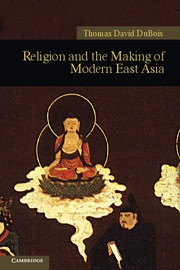Book contents
- Frontmatter
- Contents
- List of Boxes, Figures, and Maps
- Preface
- 1 In the beginning: Religion and history
- 2 Ming China: The fourteenth century's new world order
- 3 The Buddha and the shōgun in sixteenth-century Japan
- 4 Opportunities lost: The failure of Christianity, 1550–1750
- 5 Buddhism: Incarnations and reincarnations
- 6 Apocalypse now
- 7 Out of the twilight: Religion and the late nineteenth century
- 8 Into the abyss: Religion and the road to disaster during the early twentieth century
- 9 Brave new world: Religion in the reinvention of postwar Asia
- 10 The globalization of Asian religion
- Glossary
- Timeline of dynasties and major events
- Suggestions for further reading
- Index
1 - In the beginning: Religion and history
Published online by Cambridge University Press: 05 June 2012
- Frontmatter
- Contents
- List of Boxes, Figures, and Maps
- Preface
- 1 In the beginning: Religion and history
- 2 Ming China: The fourteenth century's new world order
- 3 The Buddha and the shōgun in sixteenth-century Japan
- 4 Opportunities lost: The failure of Christianity, 1550–1750
- 5 Buddhism: Incarnations and reincarnations
- 6 Apocalypse now
- 7 Out of the twilight: Religion and the late nineteenth century
- 8 Into the abyss: Religion and the road to disaster during the early twentieth century
- 9 Brave new world: Religion in the reinvention of postwar Asia
- 10 The globalization of Asian religion
- Glossary
- Timeline of dynasties and major events
- Suggestions for further reading
- Index
Summary
One morning early in 1551, a Spanish priest with Portuguese sponsors gazed out upon the great and ancient city of Kyoto. He had traveled from India to Japan to spread the Catholic faith, and to the capital in hope of receiving an audience with the emperor. We may never know why the priest was not granted his interview: was it the ridiculous cape that people said made him look like a flying bat, his ignorance of court protocol, or possibly just his horrible smell? But others were certainly happy to talk to him: access to the priests also meant access to lucrative trade routes, Western science, and, most importantly, European firearms. Before long, the missionaries had proven such a disruption that Japan would eventually ban Christianity and “seal the country,” closing its door to nearly all foreigners for over two centuries.
Three centuries later, a few thousand people calling themselves God Worshippers gathered in a remote village in China's misty southern mountains to witness a solemn ceremony. That morning, Hong Xiuquan, a thirty-seven-year-old failed scholar who claimed to be the younger brother of Jesus Christ, was to be crowned monarch of the Heavenly Kingdom of Great Peace. Within four years, his kingdom covered nearly half of China. The financial cost of crushing its long-haired army dealt a deathblow to the mighty Qing Empire. The human cost was twenty million lives: more than twice the number killed on both sides of the First World War.
- Type
- Chapter
- Information
- Religion and the Making of Modern East Asia , pp. 1 - 14Publisher: Cambridge University PressPrint publication year: 2011



